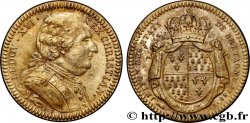fjt_072143 - BRETAGNE (ÉTATS DE...) Jeton AR 29, États de Rennes 1728
non disponibile.
Articolo venduto sul nostro negozio
Prezzo : 60.00 €
Articolo venduto sul nostro negozio
Prezzo : 60.00 €
Tipo : Jeton AR 29, États de Rennes
Data: 1728
Metallo : argento
Diametro : 29 mm
Asse di coniazione : 6 h.
Orlo : cannelée
Commenti sullo stato di conservazione:
De petites marques de manipulation avec une usure faible sur les reliefs sinon un très bel exemplaire
N° nelle opere di riferimento :
Diritto
Titolatura diritto : LUD. XV. REX - CHRISTIANISS..
Descrittivo diritto : Buste à droite en habit, avec cravate et grand cordon, au-dessous signature DU VIVIER. F..
Traduzione diritto : (Louis XV roi très chrétien).
Rovescio
Titolatura rovescio : URBS RHEDONUM INCENSA RESURGENS. ; À L’EXERGUE COM. ARM./ 1728.
Descrittivo rovescio : La ville de Rennes tourelée à gauche, présentant un plan au roi ; elle pose la main gauche sur les armes de la ville ; sous leurs pieds REST. SUO..
Commento
Le revers fait référence à la reconstruction de la ville suite à l’incendie du 23 septembre 1720 qui ravage durant six jours environ 900 maisons du centre-ville. Sous les ordres du maire Rallier du Baty, la reconstruction est confiée à l’ingénieur Isaac Robelin et sera réalisée par Jacques Gabriel, premier architecte du roi. Le centre aux ruelles tortueuses laissera alors la place à des voies à l’équerre, la pierre remplace comme matériau de construction le bois qui est interdit.
The reverse refers to the reconstruction of the city following the fire of September 23, 1720, which ravaged approximately 900 houses in the city center for six days. Under the orders of Mayor Rallier du Baty, the reconstruction was entrusted to the engineer Isaac Robelin and was carried out by Jacques Gabriel, the king's first architect. The center with its winding streets then gave way to square roads, and stone replaced wood, which was banned, as a building material.
The reverse refers to the reconstruction of the city following the fire of September 23, 1720, which ravaged approximately 900 houses in the city center for six days. Under the orders of Mayor Rallier du Baty, the reconstruction was entrusted to the engineer Isaac Robelin and was carried out by Jacques Gabriel, the king's first architect. The center with its winding streets then gave way to square roads, and stone replaced wood, which was banned, as a building material.








 Segnalare un errore
Segnalare un errore Stampate la pagina
Stampate la pagina Condividi mia selezione
Condividi mia selezione Fai una domanda
Fai una domanda Consegnare / vendere
Consegnare / vendere
 Descrittivo
Descrittivo










